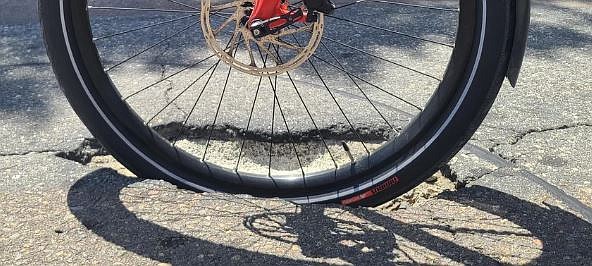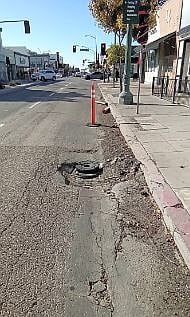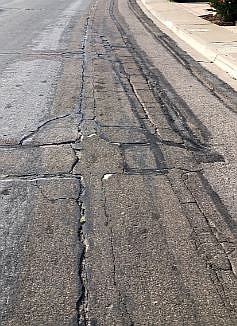 Facebook
Facebook
 X
X
 Instagram
Instagram
 TikTok
TikTok
 Youtube
Youtube

San Diegans have logged 458 pothole repair requests to the city in the last two weeks. And they're not all in Mira Mesa, which has the most pothole reports in 2023.
According to a study released in July by SellMax, which buys many pothole damaged cars, the numbers went like this: Mira Mesa (1,962), Kearny Mesa (1,797), and Clairemont Mesa (1,537).
Recent hotspots are in neighborhoods like Golden Hill, where the city has paused many repairs due to its undergrounding of utility lines, to avoid further digging.

In addition to numerous reports along 33rd Street, University Avenue pops up — "right by the Asian food place" — among other locations like between Ibis and Goldfinch, where shocks are reportedly being ruined.
So does W. Washington Street, with "massive potholes" noted in the eastbound left turn lanes right before San Diego Ave.
On Washington Street, "bollards down" could mean hazards for bikes. And unlike Mira Mesa, which is known for its high traffic, not bike lanes, some neighborhoods rated highly for cycling conditions are also high in potholes.

At two locations on Gilman Drive in La Jolla, bike lanes were at risk. A temporary bike lane in a construction zone had a pothole "that’s in horrible shape for a cyclist to hit."
To the right, should a rider swerve to dodge the hole, were concrete barricades in the right lane.
In the second report, across from the entrance to the Gilman park and ride, in the southbound bike lane between the I5 south entrance lanes and the car lane — "the pothole is growing."
Potholes left drivers with $26.5 billion in repair bills in 2021, the SellMax study said. For cyclists, it's more than busted tires, suspensions and shocks.
The city paid $500,000 to a cyclist who suffered a traumatic brain injury in 2017 after hitting rough pavement in a bike lane buckled by tree roots.
Another common way potholes form is when water seeps into cracks in the road's surface, which is then weakened by the vibration of tires, according to the city. More rain, more potholes.

Not all potholes are treated equally. How bad the disrepair is now factored along with neighborhood equity, climate resiliency, mobility and nearness to parks and libraries in deciding what gets fixed.
A case on Murray Park Dr. opened on November 27 and closed November 28. The city noted it is prioritizing street repairs based mainly on the Overall Condition Index.
A new infrastructure prioritization policy the city approved last year focuses on previously underserved neighborhoods, which also cropped up in several recent reports.
"There are an excessive numbers of potholes," reads one for south of the intersection of E. San Ysidro Blvd and Willow Rd, where the potholes are 2-3 feet wide and a couple inches deep.
The city is expected to release a report this fall — an overall condition index — that will help sort out the most important road repairs and improve biking conditions.


San Diegans have logged 458 pothole repair requests to the city in the last two weeks. And they're not all in Mira Mesa, which has the most pothole reports in 2023.
According to a study released in July by SellMax, which buys many pothole damaged cars, the numbers went like this: Mira Mesa (1,962), Kearny Mesa (1,797), and Clairemont Mesa (1,537).
Recent hotspots are in neighborhoods like Golden Hill, where the city has paused many repairs due to its undergrounding of utility lines, to avoid further digging.

In addition to numerous reports along 33rd Street, University Avenue pops up — "right by the Asian food place" — among other locations like between Ibis and Goldfinch, where shocks are reportedly being ruined.
So does W. Washington Street, with "massive potholes" noted in the eastbound left turn lanes right before San Diego Ave.
On Washington Street, "bollards down" could mean hazards for bikes. And unlike Mira Mesa, which is known for its high traffic, not bike lanes, some neighborhoods rated highly for cycling conditions are also high in potholes.

At two locations on Gilman Drive in La Jolla, bike lanes were at risk. A temporary bike lane in a construction zone had a pothole "that’s in horrible shape for a cyclist to hit."
To the right, should a rider swerve to dodge the hole, were concrete barricades in the right lane.
In the second report, across from the entrance to the Gilman park and ride, in the southbound bike lane between the I5 south entrance lanes and the car lane — "the pothole is growing."
Potholes left drivers with $26.5 billion in repair bills in 2021, the SellMax study said. For cyclists, it's more than busted tires, suspensions and shocks.
The city paid $500,000 to a cyclist who suffered a traumatic brain injury in 2017 after hitting rough pavement in a bike lane buckled by tree roots.
Another common way potholes form is when water seeps into cracks in the road's surface, which is then weakened by the vibration of tires, according to the city. More rain, more potholes.

Not all potholes are treated equally. How bad the disrepair is now factored along with neighborhood equity, climate resiliency, mobility and nearness to parks and libraries in deciding what gets fixed.
A case on Murray Park Dr. opened on November 27 and closed November 28. The city noted it is prioritizing street repairs based mainly on the Overall Condition Index.
A new infrastructure prioritization policy the city approved last year focuses on previously underserved neighborhoods, which also cropped up in several recent reports.
"There are an excessive numbers of potholes," reads one for south of the intersection of E. San Ysidro Blvd and Willow Rd, where the potholes are 2-3 feet wide and a couple inches deep.
The city is expected to release a report this fall — an overall condition index — that will help sort out the most important road repairs and improve biking conditions.
Comments